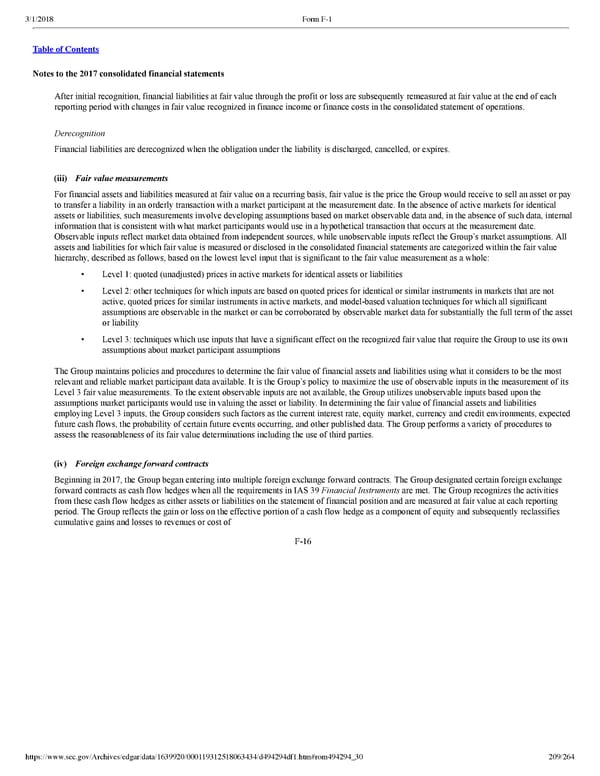209/264 Notes to the 2017 consolidated financial statements After initial recognition, financial liabilities at fair value through the profit or loss are subsequently remeasured at fair value at the end of each reporting period with changes in fair value recognized in finance income or finance costs in the consolidated statement of operations. Derecognition Financial liabilities are derecognized when the obligation under the liability is discharged, cancelled, or expires. (iii) Fair value measurements For financial assets and liabilities measured at fair value on a recurring basis, fair value is the price the Group would receive to sell an asset or pay to transfer a liability in an orderly transaction with a market participant at the measurement date. In the absence of active markets for identical assets or liabilities, such measurements involve developing assumptions based on market observable data and, in the absence of such data, internal information that is consistent with what market participants would use in a hypothetical transaction that occurs at the measurement date. Observable inputs reflect market data obtained from independent sources, while unobservable inputs reflect the Group’s market assumptions. All assets and liabilities for which fair value is measured or disclosed in the consolidated financial statements are categorized within the fair value hierarchy, described as follows, based on the lowest level input that is significant to the fair value measurement as a whole: • Level 1: quoted (unadjusted) prices in active markets for identical assets or liabilities • Level 2: other techniques for which inputs are based on quoted prices for identical or similar instruments in markets that are not active, quoted prices for similar instruments in active markets, and modelbased valuation techniques for which all significant assumptions are observable in the market or can be corroborated by observable market data for substantially the full term of the asset or liability • Level 3: techniques which use inputs that have a significant effect on the recognized fair value that require the Group to use its own assumptions about market participant assumptions The Group maintains policies and procedures to determine the fair value of financial assets and liabilities using what it considers to be the most relevant and reliable market participant data available. It is the Group’s policy to maximize the use of observable inputs in the measurement of its Level 3 fair value measurements. To the extent observable inputs are not available, the Group utilizes unobservable inputs based upon the assumptions market participants would use in valuing the asset or liability. In determining the fair value of financial assets and liabilities employing Level 3 inputs, the Group considers such factors as the current interest rate, equity market, currency and credit environments, expected future cash flows, the probability of certain future events occurring, and other published data. The Group performs a variety of procedures to assess the reasonableness of its fair value determinations including the use of third parties. (iv) Foreign exchange forward contracts Beginning in 2017, the Group began entering into multiple foreign exchange forward contracts. The Group designated certain foreign exchange forward contracts as cash flow hedges when all the requirements in IAS 39 Financial Instruments are met. The Group recognizes the activities from these cash flow hedges as either assets or liabilities on the statement of financial position and are measured at fair value at each reporting period. The Group reflects the gain or loss on the effective portion of a cash flow hedge as a component of equity and subsequently reclassifies cumulative gains and losses to revenues or cost of F16
 Spotify F1 | Interactive Prospectus Page 208 Page 210
Spotify F1 | Interactive Prospectus Page 208 Page 210